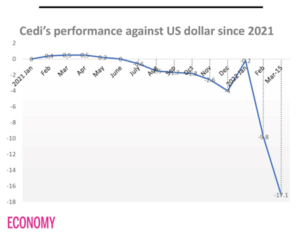Recent fiscal policy measures undertaken by government to tighten expenditure promise well for sovereign issuances, but analysts are cautioning of an upside risk to government’s fiscal projections due to the rigid (non-discretionary) nature of its expenditure items.
Non-discretionary expenditures such as total employee compensation, interest payment and statutory allocations add up to 99.6 percent of total projected revenue for the year 2022. Consequently, all the projected revenue is consumed without accounting for capital expenditure (CAPEX) and goods and services.
“There is no doubt that the announced measures by government to tighten expenditure are credit-positive for the sovereign, and so you may see a marginal decline in yields to reflect the positive signal. However, the market still understands that there’s an inherent fiscal risk that does not go away with these measures,” Senior Analyst with Databank, Courage Kingsley Martey, said in an interview with B&FT.

With the risk of revenue underperformance, government seeks to pursue more expenditure cuts to stay on the debt and fiscal sustainability path as well as achieve its fiscal deficit target of 7.4 percent of Gross Domestic Product (GDP) for 2022. Government projects to achieve a total revenue and grants figure of GH¢100.52billion at 20 percent of GDP, with additional revenue measures and policies during the year.
“You will have noticed what a challenge it was for government to come up with a range of cost-cutting measures in the budget, because there is little wriggle-room allowed in the budget for such. You will also notice that while government was able to provide a figure of GH¢3.5billion in expected savings from the recently-announced cuts, there seems to be more stimulation required to determine the actual savings from the 20 percent cut earlier announced,” Mr. Martey noted.
Addressing the potential risk of fiscal slippages arising from the non-discretionary expenditure items, the senior analyst said: “This requires long-term structural adjustments or reforms to achieve a meaningful fiscal space”.
Expenditure cuts
Government has increased its discretionary expenditure cut by 10 percent following the initial announcement of a 20 percent cut in expenditure in Jan 2022.
It also plans to cut back on the fuel coupon allocation to all political appointees and heads of government institutions by 50 percent from April 1, 2022. Furthermore, ministers and heads of State-Owned Enterprises (SOEs) will contribute 30 percent of their salaries from April to December 2022 to the Consolidated Fund. Government will also review the energy sector Independent Power Producers (IPPs) capacity charges to reduce excess capacity payments by 20 percent, thus saving GH¢1.5billion by the end of Q3-2022.
Revenue Measures
According to Apakan Securities Limited, although government projects total revenue and grants at 20 percent of GDP with additional revenue measures and policies; the impasse with introducing some of the revenue measures – particularly the reduced 1.5 percent E-levy, pose an upside risk to revenue underperformance this year.
Nonetheless, the Finance Minister reiterated that efforts are being made to fast-track passage of the E-levy and tax exemptions bills.
In addition, government will seek to implement the E-VAT, E-commerce, E-Gaming initiatives by end of April 2022 to support its domestic revenue generation drive.
Despite some positives from the policy measures taken by both the fiscal and monetary authorities to help tame FX pressures, control inflation and boost investor confidence in the near-term, Apakan Securities Ltd. expressed concerns that weak revenue performance and rigidity of expenditures cuts could pose an upside risk to fiscal projections.










